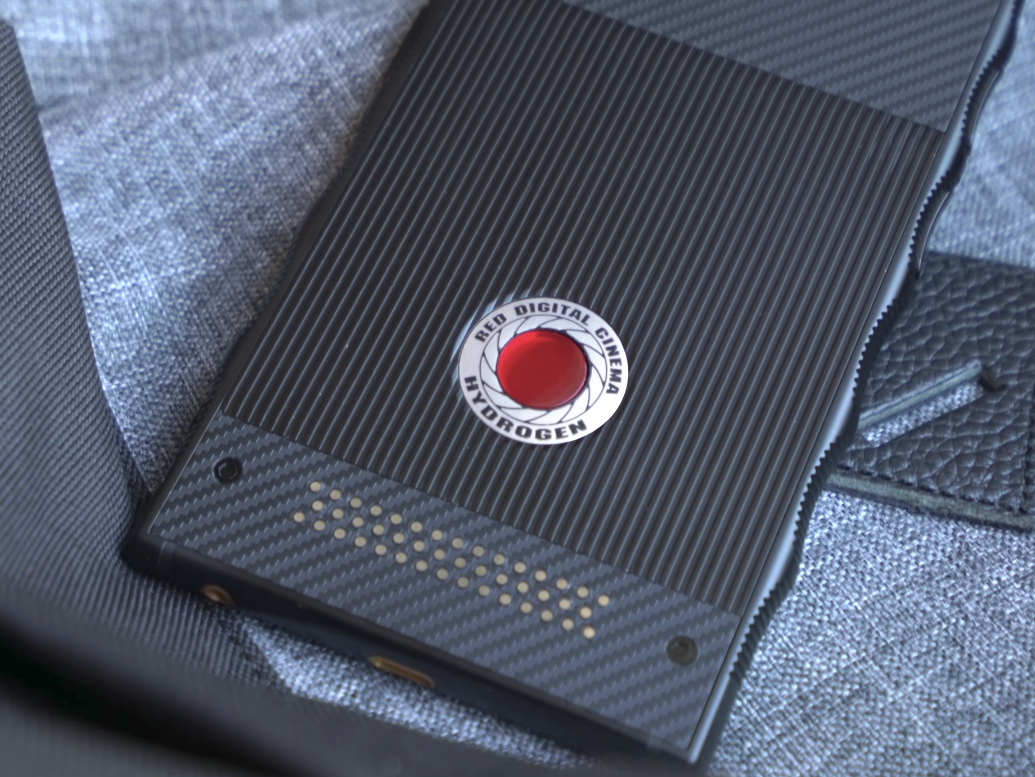Last summer, the professional camera company RED announced it would release the “world’s first holographic media machine” in 2018.
The Hydrogen One phone, starting at $1,195, was immediately available to preorder, but the launch date has been pushed a few times; most recently to August, due to reasons including carrier deals, as outlined in a post on the RED forum.
But pre-order customers will be happy to know that the Hydrogen One will officially be available for Verizon and AT&T when it rolls out this summer.
RED initially teased an image of the Hydrogen One and gave the popular YouTube tech reviewer Marques Brownlee (known as MKBHD) a nonfunctional prototype, but didn’t share much else for several months. In a January update, RED’s founder Jim Jannard shared details about the phone, which both he and the company’s president, Jarred Land, already own.
"I can proudly say that my current phone (and Jarred's) is a working HYDROGEN One... serial numbers EVT1- 0001 and 0002," Jannard wrote on a RED message board. "While there are still a few things to add, it does everything we need from a cell phone... plus display 4-view content. It is awesome. If we never sell one phone... I am totally happy. We both have exactly what we wanted."
Here's a closer look at the Hydrogen One smartphone:
This is the nonfunctional prototype Marques reviewed in July 2017. Right away, you can see its design is much busier than those of most other smartphones. The back has a mix of metal and Kevlar, with a big dual-lens camera, four screws in the corners, a big ruby-like logo, and modular-accessory pins at the bottom.

RED says the base version of the Hydrogen One will use aluminum (for $1,195) and a pricier model will be made of titanium ($1,595).
The sides of the phone, meanwhile, are grooved to fit your fingers. On one side, there's a power button that doubles as a fingerprint scanner, as well as a dedicated button for video recording.

Of the Hydrogen One's industrial design, Jannard said, "This works."
He added: "The scallops make it easier to hold, fish out of your pocket... and looks cool as hell."
On the other side of the phone, you'll see volume buttons.

At the bottom, there's a USB-C port and a headphone jack.

The phone will have multichannel spatial sound for both the internal stereo speakers and the headphones, the update post says. Jannard said the phone would also include a dual SIM slot, which is extremely useful for travelers.
The front of the phone looks pretty standard, with a handful of speaker grilles dotted around a 5.7-inch display. But don't expect the slim bezels of a Samsung Galaxy S8 or an iPhone X here.

In 2D mode, or normal cellphone mode, the resolution is said to be 2560x1440. That's sharper than the 2463x1125 resolution of the slightly bigger iPhone X, which has a 5.8-inch display.
Brownlee said RED walked him through an early demo of the Hydrogen One's "holographic" display tech but that he wasn't able to show it on camera. Brownlee suggested it was a tad rough around the edges and still hard to say how much video content will use it.

For the "holographic" mode, Jannard says, the screen dims a bit before it pops out an image you can see without needing special glasses.
Jannard calls this "4V resolution" and says it's "better than 3D," but what that means isn't completely clear.
The "holographic" tech is optional; if you want to use the Hydrogen One without it, you can. But it's apparently going to have a very large battery for capturing and playing content. Buyers might want to take advantage of the size - and the price.
The Hydrogen One is a pretty large, relatively thick rectangle. Brownlee's comparison shows it's a bit taller and wider than an iPhone 7 Plus and a OnePlus 5.

The smartphone "weighs about 2 ounces more than most 5.7-inch cell phones," since it's a few millimeters bigger and a bit thicker, Jannard said.
"Think SOLID," he added.
Brownlee also tested a potential modular camera accessory. The idea here is to snap on lenses and sensors that would make the Hydrogen One's image quality compete with that of higher-end mirrorless and other small form-factor shooters — and possibly even work as part of a larger professional-style rig.

The stackable multicomponent modular system is "done through our pogo pin system on the back of the phone," Jannard said.
The phone won't need an additional module to shoot 3D or 4V on either the front or the back cameras, though. The other for the latest delay (in addition to finalizing carrier deals) was that RED wanted the phone to be able to shoot 4V in real time rather than having it convert 3D to 4V, according to the April post.
"You can Face Chat in 4V realtime. You can post 4V immediately," he said. "I am quite sure it was the right decision to push the launch if only for this."
Brownlee's accessory was also nonfunctional — so again, it's too soon to say how well all of this will work. But unsurprisingly, it looks as if it would make the phone even thicker.

The modules might be worth the extra thickness, though. Jannard teased a YouTube-like network to "sell your 4V projects or give them away for free."
Jannard also mentioned an announcement about social-media partners, meaning you might be able to share "holographic" videos on your existing platforms.
To see more of the Hydrogen One phone, check out Brownlee's full video.
http://www.youtube.com/watch?v=tQzqFbwWPSk?ecver=1
RED is showing prototypes of the Hydrogen One phone to prospective content-production partners.
Pre-order customers will get to see advanced prototypes at a May 19 event at RED Studios, where they'll be able to view content shot by a Hydrogen One, use it, and "probably help [RED] decide whether or not to include it in the lineup," said Jannard. AT&T will be giving a public demo of the phone at its AT&T SHAPE event in Los Angeles on June 2 and 3.
If the Hydrogen One is indeed a modular, glasses-free 3D device, it'll be one of the more interesting smartphones we've seen recently - even if it is chunky and expensive. We'll have to see a working model first, so hopefully we'll have a better idea after these demos.
Jeff Dunn contributed to an earlier version of this post.

